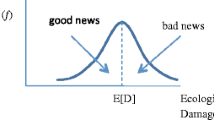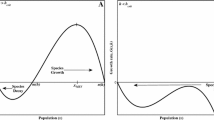Abstract
In analyses that attempt to estimate the costs of species invasions, it has been typical to report the costs of management and/or to multiply per-unit costs by the number affected to arrive at a total. These estimates are of limited value for most policy questions. We start our discussion by recognizing that biological pollutants such as aquatic invasive species are like conventional pollutants in important ways and appeal to the well-developed literature on conventional pollution to guide our thinking into how best to conceptualize the problem. We use a standard pollution control framework to identify the margins over which costs and benefits should be estimated to guide wise decision-making. We then use examples from the literature to illustrate how transactions in related markets can be used to estimate the benefits of management. The roles of adaptation, mitigation, and species population growth have particular relevance and are highlighted. In the final section of the paper, we think through the conditions under which investing in genetic biocontrol methods would be economically justified.



Similar content being viewed by others
References
Abdalla CW (1994) Groundwater values from avoidance cost studies: implications for policy and future research. Amer J Agr Econ 76:1062–1067
Bajer P, Sullivan G, Sorensen P (2009) Effects of a rapidly increasing population of common carp on vegetative cover and waterfowl in a recently restored Midwestern shallow lake. Hydrobiologia 632:235–245. doi:10.1007/s10750-009-9844-3
Baumol WJ, Oates WE (1988) The theory of environmental policy, 2nd edn. Cambridge University Press, Cambridge
Bockstael NE, Freeman AM, Kopp RJ, Portney PR, Smith VK (2000) On measuring economic values for nature. Environ Sci Technol 34:1384–1389. doi:10.1021/es990673l
Breukelaar ALE, Klein BJ, Tatrai I (1994) Effects of benthivorous bream (Abramis brama) and carp (Cyprinus carpio) on sediment resuspensions and conconcentrations of nutrients and chlorophyll A. Freshw Biol 32:113–121. doi:10.1111/j.1365-2427.1994.tb00871.x
Connelly NA, O’Neill CR, Knuth BA (2007) Economic impacts of zebra mussels on drinking water treatment and electric power generation facilities. Environ Manage 40:105–112. doi:10.1007/s00267-006-0296-5
Courant PN, Porter RC (1981) Averting expenditure and the cost of pollution. J Environ Econ Manag 8:321–329. doi:10.1016/0095-0696(81)90044-9
Finnoff D, Shogren JF, Leung B, Lodge D (2007) Take a risk: preferring prevention over control of biological invaders. Ecol Econ 62:216–222. doi:10.1016/j.ecolecon.2006.03.025
Freeman AM (2003) The measurement of environmental and resource values: theory and methods. Resources for the future, Washington
Horan RD, Lupi F (2010) The economics of invasive species control and management: the complex road ahead. Resource Energy Econ 32:477–482. doi:10.1016/j.reseneeco.2010.07.001
Horan RD, Perrings C, Lupi F, Bulte EH (2002) Biological pollution prevention strategies under ignorance: the case of invasive species. Amer J Agr Econ 84:1303–1310
Horsch EJ, Lewis DE (2009) The effects of aquatic invasive species on property values: evidence from a quasi-experiment. Land Econ 85:391–409
Kapuscinski AR, Patronski TJ (2005) Genetic methods for biological control of non-native fish in the Gila River Basin Contract report to the US fish and wildlife service. University of Minnesota, Institute for Social, Economic, and Ecological Sustainability, Saint Paul
Koonce JH, Eshenroder RL, Christie GC (1993) An economic injury level approach to establishing the intensity of sea lamprey control in the Great Lakes. N Am J Fish Manage 13:1–14. doi:10.1577/1548-8675
Lougheed VL, Crosbie B, Chow-Fraser P (1998) Predictions on the effect of common carp (Cyprinus carpio) exclusion on water quality, zooplankton, and submergent macrophytes in a Great Lakes wetland. Can J Fish Aquat Sci 55:1189–1197
Lovell SJ, Drake LA (2009) Tiny stowaways: analyzing the economic benefits of a U.S. Environmental Protection Agency permit regulating ballast water discharges. Environ Manage 43:546–555. doi:10.1007/s00267-008-9215-2
Lovell SJ, Stone SF, Fernandez L (2006) The economic impacts of aquatic invasive species: a review of the literature. Agr Resource Econ Rev 35:195–208
Lupi F, Hoehn JP, Christie GC (2003) Using an economic model of recreational fishing to evaluate the benefits of sea lamprey (Petromyzon marinus) control on the St Marys River. J Great Lakes Res 29(Supplement 1):742–754. doi:10.1016/S0380-1330(03)70528-0
Mack RN, Simberloff D, Lonsdale RN, Evans H, Clout M, Bazzaz FA (2000) Biotic invasions: causes, epidemiology, global consequences and control. Ecol Appl 10:689–710
McDonald M (1883) Report of the distribution of carp during the season of 1882. United States Commission on Fish and Fisheries, Washington
McIntosh CR, Shogren JF, Finnoff DC (2010) Invasive species and delaying the inevitable: valuation evidence from a national survey. Ecol Econ 69:632–640. doi:10.1016/j.ecolecon.2009.09.014
Olson LJ, Roy S (2008) Controlling a biological invasion: a non-classical dynamic economic model. Econ Theory 36:453–469. doi:10.1007/s00199-007-0281-0
OTA (U.S. Congress Office of Technology Assessment) (1993) Harmful non-indigenous species in the United States. U.S. Government Printing Office, Washington
Pimentel D, Lach L, Zuniga R, Morrison D (2000) Environmental and economic costs of nonindigenous species in the United States. Bio Sci 50:53–65. doi:10.1641/0006-3568
Rosen S (1974) Hedonic prices and implicit markets: product differentiation in pure competition. J Polit Econ 82:34–55
Simberloff D (2009) We can eliminate invasions or live with them: successful management projects. Biol Invasions 11:149–157. doi:10.1007/s10530-008-9317-z
Swanson BL, Swedberg DV (1980) Decline and recovery of the Lake Superior Gull Island Reef lake trout (Salvelinus namaycush) population and the role of Sea Lamprey (Petromyzon marinus) predation. Can J Fish Aquat Sci 37:2074–2080. doi:10.1139/f80-248
Acknowledgments
The authors gratefully acknowledge insightful comments from Anne Kapuscinski, Leah Sharpe and two anonymous reviewers. This research has been supported by the Minnesota Agricultural Experiment Station.
Author information
Authors and Affiliations
Corresponding author
Rights and permissions
About this article
Cite this article
Homans, F.R., Smith, D.J. Evaluating management options for aquatic invasive species: concepts and methods. Biol Invasions 15, 7–16 (2013). https://doi.org/10.1007/s10530-011-0134-4
Received:
Accepted:
Published:
Issue Date:
DOI: https://doi.org/10.1007/s10530-011-0134-4




